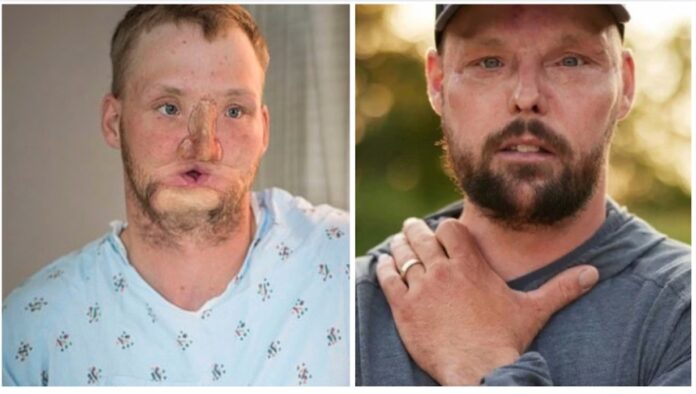- Devastating Injury: At 21, Andy Sandness survived a self-inflicted gunshot that destroyed most of his face, leaving him disfigured and isolated for a decade.
- Pioneering Face Transplant: In 2016, Mayo Clinic performed a 56-hour face transplant surgery, giving Sandness a new face and restoring 70–75% of his facial movement.
- New Life and Family: Post-surgery, Sandness regained confidence, married a nurse he met during recovery, and now has two children, embracing life fully again.
A single moment with a gun nearly ended Andy Sandness’s life—and changed it forever.
At just 21 years old, Sandness put a rifle beneath his chin and pulled the trigger in a devastating suicide attempt. He survived. But his face was nearly destroyed.
He lost his nose, jaw, teeth, lips, and most of his facial structure. Though doctors at the Mayo Clinic were able to save his life, they could not save his appearance.
A Second Chance Comes 10 Years Later
For years, Sandness lived in the shadows—haunted by stares in public, discolored prosthetics, and a mouth so small he could barely eat. Children were afraid of him. Strangers looked away. He became a recluse, hiding from the world that once felt too heavy to bear.
But in 2016, ten years after the suicide attempt, Sandness got a phone call that would change everything again: a donor face had become available.
The 56-Hour Transplant That Changed His Life
In a groundbreaking 56-hour surgery—the 12th face transplant ever performed in the United States—surgeons gave Sandness a new face.
The donor, Caden “Rudy” Ross, was a 21-year-old father-to-be who had died by suicide just weeks before. His young widow, eight months pregnant at the time, agreed to donate his organs—offering Sandness a second chance at life.
When Sandness finally saw his new face in the mirror three weeks after the surgery, he couldn’t speak. Instead, he wrote down on a piece of paper: “It far exceeded my expectations.”
Feeling, Movement, and a Smile Again
Since then, his life has completely transformed.
“I never expected that to happen in my whole life and I don’t have to live in fear anymore. I can go out and be myself. I’m allowed to be myself again.”
He now has feeling in most of his face. He can smile, frown, kiss, even furrow his brow when he’s upset. Nearly 75 percent of his facial movement has returned.
“The thing that helps the most is I have my original eyes and eyebrows,” he said. “So that stuff never changed—and that allows a lot of movement.”
No Longer Hiding from the World
After years of isolation, Sandness reclaimed his life. He started going to restaurants again. He returned to the hockey games he once loved. People stopped staring. Kids no longer hid behind their parents. One boy even smiled and waved at him in an elevator—a small moment Sandness says he’ll never forget.
“That’s when I knew it was successful,” he said. “We’d gotten most everything that we wanted.”
Finding Love After the Pain
In 2017, just a year after his transplant, Sandness fell in love with Kim, a nurse he met at the Mayo Clinic. They married in May 2020 and have since welcomed two children: Wyatt Lee and Grace Catherine.
Asked if the face transplant helped him start a family, Sandness paused. “My wife says 100 percent we would have gotten married without it,” he admitted. “But for me—I’m not so sure.”
A Surgeon’s Pride and a Donor’s Legacy
His plastic surgeon, Dr. Samir Mardini, has watched his transformation closely. “We helped him become normal,” Mardini said. “When I look at the emotions he expresses—it appears so natural and effortless. It’s a miracle.”
The donor match came in July 2016. Caden Ross, the young donor, left behind a pregnant wife named Lilly. She agreed to the transplant but was unsure what it would be like to see her late husband’s face again—on someone else.
In November 2017, she met Sandness in person.
She needn’t have worried. “He didn’t look like my husband,” she said, relieved. “But I was proud. Seeing what it did for him made me so proud.”
The Pain That Lingers
Still, the trauma left lasting wounds on Sandness’s family. “My mom has PTSD,” he revealed. “My brother said after the transplant, ‘You don’t know how relieved we are that you can live a normal life.’”
He added that families of suicide survivors face a different kind of pain. “In that situation, you don’t care,” he said. “But it’s going to screw with your family. The cops don’t clean that stuff up—you have to. It was really hard on my family.”
Living Fully—And Finally Smiling
Now 16 years after that dark day, Sandness is not only surviving—he’s thriving.
He swims with his kids, eats what he wants (except grapefruit, which interferes with his anti-rejection meds). He smiles at strangers and laughs again.
“I have a functioning face,” he said. “When I smile—I can actually smile.”
And that, he says, is everything.




